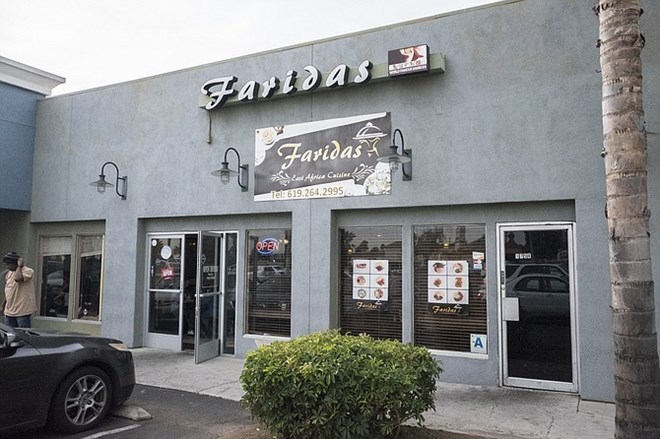
Friday February 23, 2018
By Ian Anderson
Faridas makes it easy for a first-timer to eat well
What was I thinking? Since the 1990s, the Somali population in San Diego has reportedly become the second largest the U.S. — with estimates ranging up to twenty thousand people — making it one of the few cities in America where trying Somali cuisine is even an option.
Specifically, Faridas is in the Chollas Creek part of City Heights. My first visit, I shared my lack of experience with the young server behind the counter. She pointed out several dishes from the Hilal menu, first directing me to a variety of sambusas and ultimately steering me to the goat.
The word "sambusa" instantly rang familiar, and with good reason. It shares the same heritage as India's samosa. Both are triangular pastries stuffed with spiced meat or vegetables. Unlike many Indian restaurants, Farida's offers beef as an option, as well as chicken, potato, and spinach. Each go for a buck, and you cannot go wrong.
The goat may be a different story. From what I've read, goat ranks at or near the top of the list of preferred meats in Somalia, and here I was told it's a signature dish. Simply listed on the menu as "goat meat," it's braised until tender, then sautéed with bell peppers, onions, and spices.
I got a little cumin, and subtle curry as well. But the goat flavor itself came through the most. Unlike the rest of the world, we don't eat a lot of goat in the U.S., so it always comes off a bit exotic to the American palate. If you're a fan of lamb or grass-fed beef, you're far more likely to enjoy this soft, aromatic preparation.
If you're not there yet, start with the beef or chicken suuqar. Also sautéed with peppers and onions, the cubed meats in this dish offer a more accessible introduction to the flavors of xawaash, the Somali spice blend including the likes of cumin, fenugreek, coriander, cardamom, cinnamon, and turmeric.
All of these dishes come with salad and a unique potato dish made with green beans, corn, peas, and raisins. You also get a choice of a lightly flavored basmati rice pilaf, colored yellow and orange with saffron and possibly more turmeric, or pasta. Somalia may be thousands of miles from Europe, but few nations escape Italy's culinary influence. The spaghetti noodles feature a thin coat of tomato-based sauce.
Can't decide between rice and noodles? They served me a mix of both. But if you stick to rice alone, you may be offered a banana. Apparently, the Somali thing to do is to slice one up and mix in with the rice.
That would have made a unique experience. But ultimately, Faridas served food that felt more comforting and familiar than I expected from a new experience. Credit the restaurant's approachable, home-style cooking. The spice blends may be new to me — and I'm pretty sure I'd never had raisins and potatoes in my mouth at the same time before — but the hearty, 11-dollar meals I've eaten here have all hit the spot.

